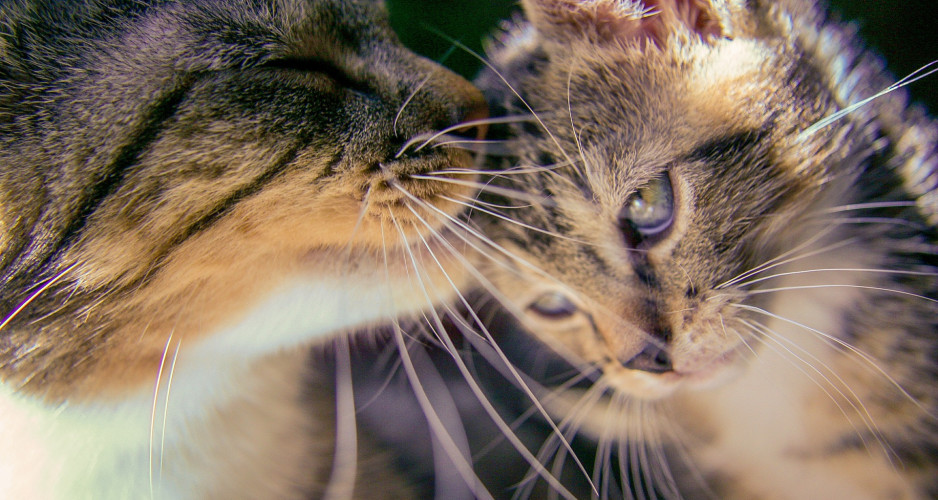Has Fluffy been breaking into the Fancy Feast stash, you ask? Maybe, but her lady curves are beautiful, and you love her anyway, you tell yourself. Then the thought crosses your mind. My Fluffy? No. Never. Oh sh*t, maybe. Is my little fur baby all grown up? I’m gonna kick that street cat’s ass!
If you find yourself having this inner dialogue, then there’s a high likelihood that your little, precious Fluffy isn’t so little anymore and may be expecting.
Although this thought may terrify you, don’t freak out. Breathe. It’s going to be okay. The Perfect Cat will help you, Fluffy, and her illegitimate, little bastards get through this. Too much?
But seriously, get excited! Although this maybe a stressful time for you and Fluffy, you’re about to strengthen the bond between you and your cat and bring some cute, adorable, little kittens into this world. And who doesn’t love kittens? Only people with no soul don’t like kittens.
Anyway, this is Part 1 of a multi-section series we’re developing to help you cat parents with your expecting cat. In this section, you’ll learn about how to tell if your cat is, in fact, prego and what the major indicators are. Here’s what you need to know:
1. First, ask yourself some preliminary questions
There are a few signs that usually indicate a cat is pregnant. First off is your cat female? Check. Is your cat spayed? No. Okay, continue reading.
2. Mixed signals
After the female cat becomes pregnant, her body will slowly begin to experience changes over the next 63 days as the fetuses grow; however, there’s actually very few visible changes in the first few weeks of cat pregnancy.
In fact, in the early stage of feline pregnancy, which is considered the first 4 weeks after fertilization, your cat could actually loose weight. Yes, cats get morning sickness too. Your cat’s appetite may be suppressed due to the nausea, but don’t worry, pregnant cats typically regain their appetites after the third week of pregnancy.
3. Tell tail signs
One of the most obvious signs indicating pregnancy is the pinking of nipples, which typically occurs in week 2. In other words, your cat’s nipples, which are located on her belly—yes under all that fur—become even pinker in color. They may even become more visible and poke through her belly fur, depending on the length of hair your cat has.
In the third week of pregnancy, you can typically feel some little kitten lumps when you feel up on your cat’s abdomen area. Of course you should make an appointment with your vet around week 3 of your pregnancy suspicions to confirm that your cat if expecting. An ultrasound can be performed starting around week 3, which will ensure the lumps you feel aren’t an indication of disease and that your cat is in fact pregnant.
4. Weight gain
Like humans, pregnant cats gradually put on weight. This is most noticeable in her sides, where fat deposits typically collect. Significant weight gain usually takes place in the middle stages of a cat’s pregnancy, typically occurring between weeks 4-6. Normal weight gain during feline pregnancy is between 20% and 30% of the cat’s total body weight.
If your cat seems to be below or above this threshold, schedule an appointment with your vet immediately. Don’t freak out, there may be some simple explanations.
For example, if your cat is below weight, her morning sickness period might be lasting longer than average and as a result is experiencing an increased loss of appetite. Your vet can prescribe something to help with the nausea to boost her appetite.
Alternatively, if your cat appears to be over weight, she may be expecting a larger than average litter (6-8 kittens); and in that case, your vet can help you to take extra precautions during your cat’s pre-labor care.
Above average weight gain could also be causing by the simple act of over eating. Just like human mothers expecting, your cat’s appetite may drastically increase during pregnancy. After all, she is eating for like 5. If this is the case, a simple solution is to exercise portion control and transition your cat to scheduled feedings.
5. Good ole’ fashioned hormones
Also like human mothers who are expecting, your cat will experience significant shifts in her hormone levels. This, of course, will also bring about noticeable changes in your cat’s mood and overall behavior.
Your cat may not be as personable, friendly, or affectionate to you as she normally is, so don’t get offended. You’d be a bi*ch too if you were carrying around like 5 babies in your tiny little body.
Your cat’s changing hormone levels will initiate her to begin the search for a place to give birth to her kittens—one of the most visible changes in normal behavior you’ll witness your cat experience during her pregnancy. In the wild, pregnant cats begin preparing for birth a couple of weeks before they go into labor. They seek out the perfect site for the big day. Ideally, this site needs to be dry and well hidden as instinctually cats know this is critical to the survival of their kittens.
That said, your cat will do the same and start looking for a good birth site in which she can safely give birth and protect her new babies. If your cat is an outdoor cat, it’s 100% recommended to let her live in doors for her pregnancy, delivery, and first few weeks of nursing. Without the protection of a human home and caretaker, the health and safety of your cat and her kittens is far less certain.
So, obviously if you and your cat get to this point, you’ve got confirmation that Fluffy will join the cat mom team. In Part 2 of this series, we’ll go into what you should do to prepare for your cat’s birth and the arrival of her new kittens. Stay tuned.

